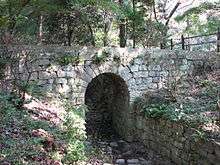Ōasahiko Shrine
Ōasahiko Shrine (大麻比古神社, Ōasahiko-jinja) is a Shinto shrine located at the base of Mt. Ōasa in Naruto, Tokushima, Japan. The kami enshrined there are Ōasahiko-no-Okami and Sarutahiko-no-Okami.
| Ōasahiko Shrine 大麻比古神社 | |
|---|---|
 Ōasahiko Shrine's haiden | |
| Religion | |
| Affiliation | Shinto |
| Deity | Ōasahiko-no-Okami Sarutahiko-no-Okami |
| Location | |
| Location | 13 Aza Hirotsuka, Bando Oasa-cho, Naruto Tokushima 〒779-0230 |
 Shown within Japan | |
| Geographic coordinates | 34°10′15.50″N 134°30′9.25″E |
| Website | |
| www | |
Enshrined kami
It is believed that in the era of Emperor Jimmu, Ame-no-Tomi-no-Mikoto came to the Awa region (an ancient region that encompassed most of present-day Tokushima Prefecture) seeking fertilized land to sow hemp seeds. The planted seeds were then cultivated by the area's population so they could produce linen called asa, which formed the base of the area's industry. Because of the impact he had on furthering the welfare of Japan, Ōasahiko Shrine was dedicated in the area to worship him as a kami named Oasahiko-no-Okami.[1]
The secondary kami enshrined at Ōasahiko is Sarutahiko-no-Okami. He is depicted as standing at the junction of heaven and earth to guide the grandchildren of Amaterasu, the Imperial Family and the founders of the human race to earth. He is primarily known for greeting and guiding Ninigi-no-Mikoto, grandson of Amaterasu, to earth.[2] After his various achievements, he was enshrined at Ōasahiko Shrine along with Oasahiko-no-Okami.[1]
History
The exact year of the foundation of Ōasahiko Shrine is unknown. The earliest documentation of the shrine, however, is found in the Engishiki, written in 927. The book, a compendium of governmental rules and procedures, lists the shrine in its list of 2,861 shrines that received offerings from the court at the annual spring festival, Kinensai.

Since the shrine's listing in the Engishiki, it became a principal area for worship for both the Tokushima area and Awaji Island. Ōasahiko continued to improve its shrine rating until it was awarded the 1st grade in 1719. In 1873, it achieved the ranked of Kokuhei Chūsha, a mid-sized shrine supported by the provincial government. As such, in 1890 all of the shrine's facilities were rebuilt and others were added, all paid for by the local government. Later, the current honden, haiden and the gaihaiden were rebuilt from the donations of worshipers. Since then, Ōasahiko Shrine has lost most of its national importance, but remains today as an important place of worship in the Tokushima area.[1]
Features
In addition to the traditional Shinto shrine structures—-such as the honden and haiden—located on the shrine premises, there are also a variety of other distinguishing featured located around the shrine.

Marking the start of an 800-meter-long (2,625 ft) road leading directly to the shrine's haiden is a large, orange torii. By using reinforced concrete and steel, this torii was first constructed in 1958 and had a height of 15.6 metres (51 ft) and a width of 11 metres (36 ft). Because of its deteriorated state, it was reconstructed in 2002 using metal tubing. The access road which follows is lined with dozens of stone tōrō donated by shrine parishioners in 2004-05.[3]
In the center of the shrine grounds is a 1000-year-old camphor tree known as Go-shinboku (ご神木). This revered tree's main trunk has a circumference of 8.3 metres (27 ft) and a maximum height of 22 metres (72 ft).[4]
Behind the main portion of the shrine grounds to the northeast is the German Bridge (ドイツ橋, Doitsu bashi). From April 1917 to December 1919, about 953 German and Austro-Hungarian soldiers were imprisoned at the nearby Bandō Prisoner of War camp during World War I. This stone bridge was built by these POWs who were held captive at the camp.
References
| Wikimedia Commons has media related to Ōasahiko Shrine. |
- "Original history". Retrieved 2008-08-21.
- Yamamoto, Yukitaka. "Sarutahiko Okami". Retrieved 2008-08-21.
- "Q&A" (in Japanese). Retrieved 2008-08-21.
- 境内案内図 (in Japanese). Retrieved 2008-08-21.